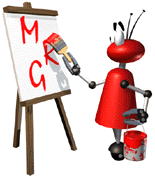
Chris Adams
MOBILE ROBOTICS RESEARCH GROUP
robot shaping
Contact: Gillian Hayes
Last updated: Fri Dec 1 22:12:57 2000
the problem with robots is... designing them by hand from scratch is difficult for humans, while designing them automatically (e.g. using learning or evolution) doesn't scale up to complicated tasks.
shaping is a way of integrating high-level domain knowledge supplied by humans, with low-level learning supplied by the computer.
The basic principles of shaping are:
- The human designer provides medium-level knowledge about how a task should be carried out. e.g. how it should be decomposed into sub-tasks, what sort of areas might be interesting to explore etc.
- The learning algorithm works out how to implement the medium-level description supplied by the designer in low-level terms that the robot can understand.
- The human designer shouldn't have to know how the low-level implementation is working. i.e. they shouldn't have to know about low-level representations, network weights, connections etc.
The idea is that shaping methods are analogous to a high-level language for describing robot tasks - the designer specifies the task in a high-level declarative fashion, and the learning algorithm compiles this into a procedural implementation. By insulating the high-level design from the low-level implementation, the designer is forced to think about the task at a more appropriate level, and the learning algorithms are freed from the constraint of having to produce humanly understandable solutions.
architectures Shaping requres the use of an underlying learning architecture with some unusual features, specifically the ability to learn sub-behaviours and then incorporate them into higher level behaviours without explicit directions from a human designer. To satisfy this and other requirements we have developed a neural implementation of a classifier system.
publications Shaping is discussed in more detail in the paper:
Robot Shaping - Principles, Methods and Architectures (Gzip'd Postscript), by Simon Perkins and Gillian Hayes, presented at the Workshop onLearning in Robots and Animals, at AISB'96, University of Sussex, UK, April 1-2, 1996.